Huaping Liu
CollabVLA: Self-Reflective Vision-Language-Action Model Dreaming Together with Human
Sep 18, 2025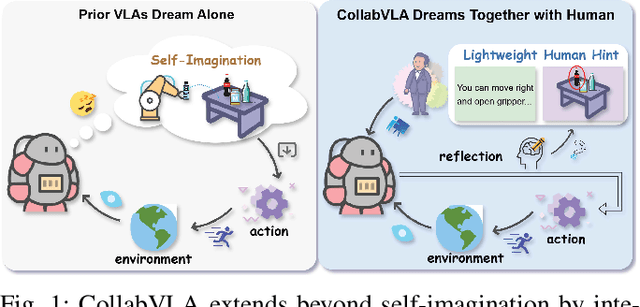
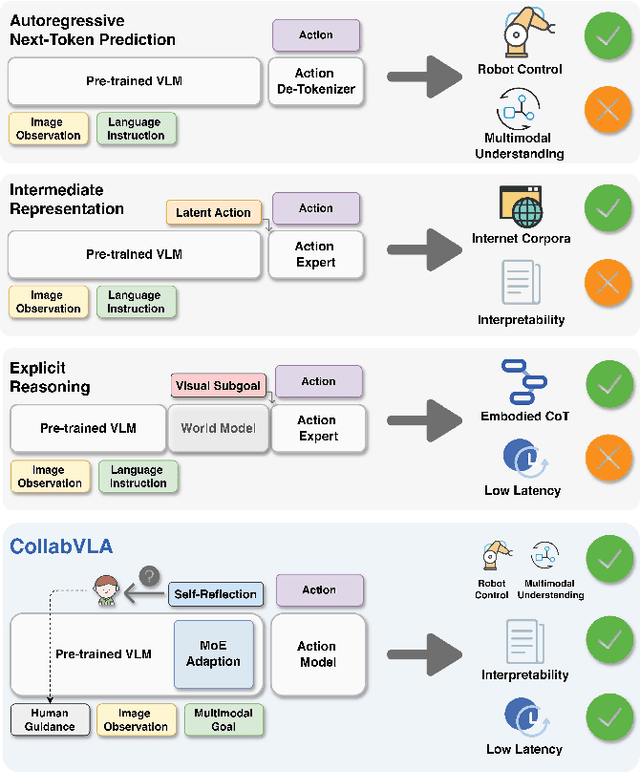

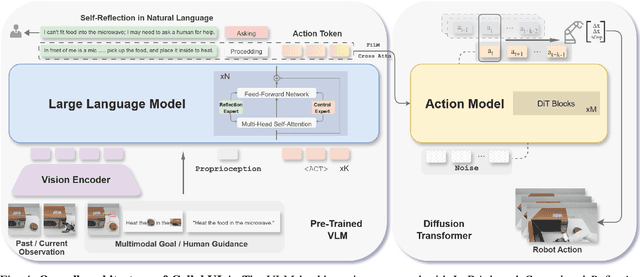
Abstract:In this work, we present CollabVLA, a self-reflective vision-language-action framework that transforms a standard visuomotor policy into a collaborative assistant. CollabVLA tackles key limitations of prior VLAs, including domain overfitting, non-interpretable reasoning, and the high latency of auxiliary generative models, by integrating VLM-based reflective reasoning with diffusion-based action generation under a mixture-of-experts design. Through a two-stage training recipe of action grounding and reflection tuning, it supports explicit self-reflection and proactively solicits human guidance when confronted with uncertainty or repeated failure. It cuts normalized Time by ~2x and Dream counts by ~4x vs. generative agents, achieving higher success rates, improved interpretability, and balanced low latency compared with existing methods. This work takes a pioneering step toward shifting VLAs from opaque controllers to genuinely assistive agents capable of reasoning, acting, and collaborating with humans.
Track Any Motions under Any Disturbances
Sep 17, 2025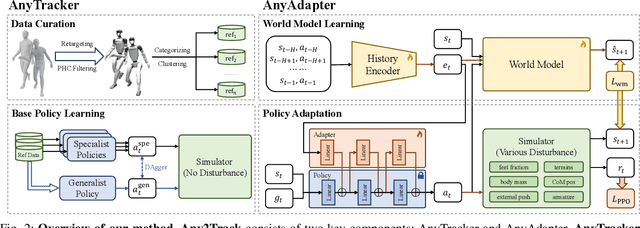

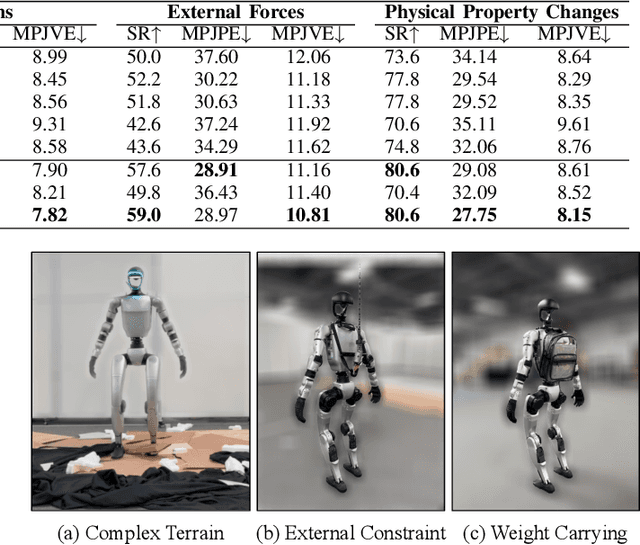

Abstract:A foundational humanoid motion tracker is expected to be able to track diverse, highly dynamic, and contact-rich motions. More importantly, it needs to operate stably in real-world scenarios against various dynamics disturbances, including terrains, external forces, and physical property changes for general practical use. To achieve this goal, we propose Any2Track (Track Any motions under Any disturbances), a two-stage RL framework to track various motions under multiple disturbances in the real world. Any2Track reformulates dynamics adaptability as an additional capability on top of basic action execution and consists of two key components: AnyTracker and AnyAdapter. AnyTracker is a general motion tracker with a series of careful designs to track various motions within a single policy. AnyAdapter is a history-informed adaptation module that endows the tracker with online dynamics adaptability to overcome the sim2real gap and multiple real-world disturbances. We deploy Any2Track on Unitree G1 hardware and achieve a successful sim2real transfer in a zero-shot manner. Any2Track performs exceptionally well in tracking various motions under multiple real-world disturbances.
S2R-Bench: A Sim-to-Real Evaluation Benchmark for Autonomous Driving
May 24, 2025



Abstract:Safety is a long-standing and the final pursuit in the development of autonomous driving systems, with a significant portion of safety challenge arising from perception. How to effectively evaluate the safety as well as the reliability of perception algorithms is becoming an emerging issue. Despite its critical importance, existing perception methods exhibit a limitation in their robustness, primarily due to the use of benchmarks are entierly simulated, which fail to align predicted results with actual outcomes, particularly under extreme weather conditions and sensor anomalies that are prevalent in real-world scenarios. To fill this gap, in this study, we propose a Sim-to-Real Evaluation Benchmark for Autonomous Driving (S2R-Bench). We collect diverse sensor anomaly data under various road conditions to evaluate the robustness of autonomous driving perception methods in a comprehensive and realistic manner. This is the first corruption robustness benchmark based on real-world scenarios, encompassing various road conditions, weather conditions, lighting intensities, and time periods. By comparing real-world data with simulated data, we demonstrate the reliability and practical significance of the collected data for real-world applications. We hope that this dataset will advance future research and contribute to the development of more robust perception models for autonomous driving. This dataset is released on https://github.com/adept-thu/S2R-Bench.
Maximum Total Correlation Reinforcement Learning
May 22, 2025Abstract:Simplicity is a powerful inductive bias. In reinforcement learning, regularization is used for simpler policies, data augmentation for simpler representations, and sparse reward functions for simpler objectives, all that, with the underlying motivation to increase generalizability and robustness by focusing on the essentials. Supplementary to these techniques, we investigate how to promote simple behavior throughout the episode. To that end, we introduce a modification of the reinforcement learning problem that additionally maximizes the total correlation within the induced trajectories. We propose a practical algorithm that optimizes all models, including policy and state representation, based on a lower-bound approximation. In simulated robot environments, our method naturally generates policies that induce periodic and compressible trajectories, and that exhibit superior robustness to noise and changes in dynamics compared to baseline methods, while also improving performance in the original tasks.
Learn to Think: Bootstrapping LLM Reasoning Capability Through Graph Representation Learning
May 17, 2025Abstract:Large Language Models (LLMs) have achieved remarkable success across various domains. However, they still face significant challenges, including high computational costs for training and limitations in solving complex reasoning problems. Although existing methods have extended the reasoning capabilities of LLMs through structured paradigms, these approaches often rely on task-specific prompts and predefined reasoning processes, which constrain their flexibility and generalizability. To address these limitations, we propose a novel framework that leverages graph learning to enable more flexible and adaptive reasoning capabilities for LLMs. Specifically, this approach models the reasoning process of a problem as a graph and employs LLM-based graph learning to guide the adaptive generation of each reasoning step. To further enhance the adaptability of the model, we introduce a Graph Neural Network (GNN) module to perform representation learning on the generated reasoning process, enabling real-time adjustments to both the model and the prompt. Experimental results demonstrate that this method significantly improves reasoning performance across multiple tasks without requiring additional training or task-specific prompt design. Code can be found in https://github.com/zch65458525/L2T.
FlowDreamer: A RGB-D World Model with Flow-based Motion Representations for Robot Manipulation
May 15, 2025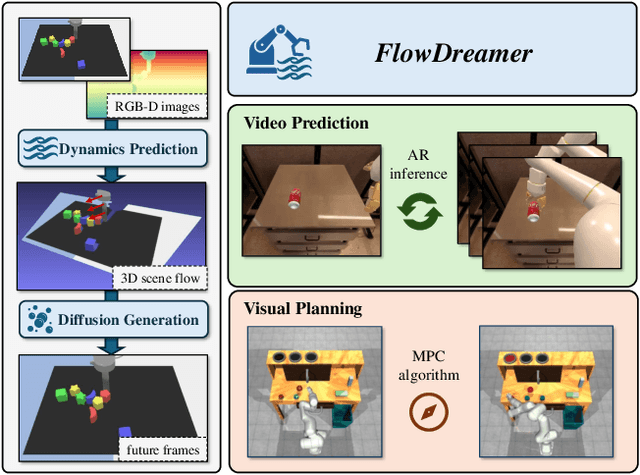



Abstract:This paper investigates training better visual world models for robot manipulation, i.e., models that can predict future visual observations by conditioning on past frames and robot actions. Specifically, we consider world models that operate on RGB-D frames (RGB-D world models). As opposed to canonical approaches that handle dynamics prediction mostly implicitly and reconcile it with visual rendering in a single model, we introduce FlowDreamer, which adopts 3D scene flow as explicit motion representations. FlowDreamer first predicts 3D scene flow from past frame and action conditions with a U-Net, and then a diffusion model will predict the future frame utilizing the scene flow. FlowDreamer is trained end-to-end despite its modularized nature. We conduct experiments on 4 different benchmarks, covering both video prediction and visual planning tasks. The results demonstrate that FlowDreamer achieves better performance compared to other baseline RGB-D world models by 7% on semantic similarity, 11% on pixel quality, and 6% on success rate in various robot manipulation domains.
Large Language Model Enhancers for Graph Neural Networks: An Analysis from the Perspective of Causal Mechanism Identification
May 15, 2025Abstract:The use of large language models (LLMs) as feature enhancers to optimize node representations, which are then used as inputs for graph neural networks (GNNs), has shown significant potential in graph representation learning. However, the fundamental properties of this approach remain underexplored. To address this issue, we propose conducting a more in-depth analysis of this issue based on the interchange intervention method. First, we construct a synthetic graph dataset with controllable causal relationships, enabling precise manipulation of semantic relationships and causal modeling to provide data for analysis. Using this dataset, we conduct interchange interventions to examine the deeper properties of LLM enhancers and GNNs, uncovering their underlying logic and internal mechanisms. Building on the analytical results, we design a plug-and-play optimization module to improve the information transfer between LLM enhancers and GNNs. Experiments across multiple datasets and models validate the proposed module.
LLM Enhancers for GNNs: An Analysis from the Perspective of Causal Mechanism Identification
May 13, 2025Abstract:The use of large language models (LLMs) as feature enhancers to optimize node representations, which are then used as inputs for graph neural networks (GNNs), has shown significant potential in graph representation learning. However, the fundamental properties of this approach remain underexplored. To address this issue, we propose conducting a more in-depth analysis of this issue based on the interchange intervention method. First, we construct a synthetic graph dataset with controllable causal relationships, enabling precise manipulation of semantic relationships and causal modeling to provide data for analysis. Using this dataset, we conduct interchange interventions to examine the deeper properties of LLM enhancers and GNNs, uncovering their underlying logic and internal mechanisms. Building on the analytical results, we design a plug-and-play optimization module to improve the information transfer between LLM enhancers and GNNs. Experiments across multiple datasets and models validate the proposed module.
Trajectory Entropy Reinforcement Learning for Predictable and Robust Control
May 07, 2025Abstract:Simplicity is a critical inductive bias for designing data-driven controllers, especially when robustness is important. Despite the impressive results of deep reinforcement learning in complex control tasks, it is prone to capturing intricate and spurious correlations between observations and actions, leading to failure under slight perturbations to the environment. To tackle this problem, in this work we introduce a novel inductive bias towards simple policies in reinforcement learning. The simplicity inductive bias is introduced by minimizing the entropy of entire action trajectories, corresponding to the number of bits required to describe information in action trajectories after the agent observes state trajectories. Our reinforcement learning agent, Trajectory Entropy Reinforcement Learning, is optimized to minimize the trajectory entropy while maximizing rewards. We show that the trajectory entropy can be effectively estimated by learning a variational parameterized action prediction model, and use the prediction model to construct an information-regularized reward function. Furthermore, we construct a practical algorithm that enables the joint optimization of models, including the policy and the prediction model. Experimental evaluations on several high-dimensional locomotion tasks show that our learned policies produce more cyclical and consistent action trajectories, and achieve superior performance, and robustness to noise and dynamic changes than the state-of-the-art.
A General Infrastructure and Workflow for Quadrotor Deep Reinforcement Learning and Reality Deployment
Apr 21, 2025Abstract:Deploying robot learning methods to a quadrotor in unstructured outdoor environments is an exciting task. Quadrotors operating in real-world environments by learning-based methods encounter several challenges: a large amount of simulator generated data required for training, strict demands for real-time processing onboard, and the sim-to-real gap caused by dynamic and noisy conditions. Current works have made a great breakthrough in applying learning-based methods to end-to-end control of quadrotors, but rarely mention the infrastructure system training from scratch and deploying to reality, which makes it difficult to reproduce methods and applications. To bridge this gap, we propose a platform that enables the seamless transfer of end-to-end deep reinforcement learning (DRL) policies. We integrate the training environment, flight dynamics control, DRL algorithms, the MAVROS middleware stack, and hardware into a comprehensive workflow and architecture that enables quadrotors' policies to be trained from scratch to real-world deployment in several minutes. Our platform provides rich types of environments including hovering, dynamic obstacle avoidance, trajectory tracking, balloon hitting, and planning in unknown environments, as a physical experiment benchmark. Through extensive empirical validation, we demonstrate the efficiency of proposed sim-to-real platform, and robust outdoor flight performance under real-world perturbations. Details can be found from our website https://emnavi.tech/AirGym/.
 Add to Chrome
Add to Chrome Add to Firefox
Add to Firefox Add to Edge
Add to Edge